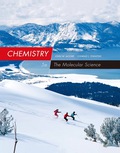
Concept explainers
(a)
Interpretation:
The empirical formula of a compound
Concept introduction:
Molecular formula of a compound is derived from empirical formula mass and molar mass of the compound as,
Moles: One mole is equivalent to the mass of the substance consists same number of units equal to the atoms present in
From given mass of substance moles could be calculated by using the following formula,
Mass: It is the quantitative measure of a substance. The amount of matter present in substance is expressed as mass. The
(a)
Explanation of Solution
Given information as: The compound contains
Here, the total amount is considered as
Calculate the moles of Carbon:
Calculate the moles of Hydrogen:
Calculate the moles of Chromium:
From the above, the mole ratio of Carbon, Hydrogen and Chromium is,
Thus, the simplified ratio becomes,
Therefore, the empirical formula is
(b)
Interpretation:
The molecular formula of a compound
Concept introduction:
Molecular formula of a compound is derived from empirical formula mass and molar mass of the compound as,
Moles: One mole is equivalent to the mass of the substance consists same number of units equal to the atoms present in
From given mass of substance moles could be calculated by using the following formula,
Mass: It is the quantitative measure of a substance. The amount of matter present in substance is expressed as mass. The
(b)
Explanation of Solution
Using the formula of osmotic pressure as shown below,
Temperature,
Osmotic pressure
The addition of solute does not change the volume of the solution; the volume of the solvent is equal to the volume of the solution. Hence,
Thus, molecular mass of the compound is
As known, the molecular formula is a multiple of the empirical formula:
The molar mass of the empirical formula
Therefore, the molecular formula is
Want to see more full solutions like this?
Chapter 13 Solutions
EBK CHEMISTRY: THE MOLECULAR SCIENCE
- Simple acids such as formic acid, HCOOH, and acetic acid, CH3COOH, are very soluble in water; however, fatty acids such as stearic acid, CH3(CH2)16COOH, and palmitic acid, CH3(CH2)14COOH, are water-insoluble. Based on what you know about the solubility of alcohols, explain the solubility of these organic acids.arrow_forwardSome lithium chloride, LiCl, is dissolved in 100 mL of water in one beaker, and some Li2SO4 is dissolved in 100 mL of water in another beaker. Both are at 10 C, and both are saturated solutions; some solid remains undissolved in each beaker. Describe what you would observe as the temperature is raised. The following data are available to you from a handbook of chemistry:arrow_forwardA compound has a solubility in water of 250 mg/L at 25C. Should this compound be characterized as a soluble or insoluble compound at 25C?arrow_forward
- Refer to Figure 13.10 ( Sec. 13-4b) to answer these questions. (a) Does a saturated solution occur when 65.0 g LiCl is present in 100 g H2O at 40 C? Explain your answer. (b) Consider a solution that contains 95.0 g LiCl in 100 g H2O at 40 C. Is the solution unsaturated, saturated, or supersaturated? Explain your answer. (c) Consider a solution that contains 50. g Li2SO4 in 200. g H2O at 50 C. Is this solution unsaturated, saturated, or supersaturated? Explain your answer. Figure 13.10 Solubility of ionic compounds versus temperature.arrow_forwardButane, C4H10, has been suggested as the refrigerant in household compressors such as those found in air conditioners. (a) To what extent is butane soluble in water? Calculate the butane concentration in water if the pressure of the gas is 0.21 atm. (kH = 0.0011 mol/kgbar at 25 C) (b) If the pressure of butane is increased to 1.0 atm, does the butane concentration increase or decrease?arrow_forwardThe osmotic pressure of a solution containing 7.0 g of insulin per liter is 23 torr at 25 C. What is the molar mass of insulin?arrow_forward
 Chemistry & Chemical ReactivityChemistryISBN:9781133949640Author:John C. Kotz, Paul M. Treichel, John Townsend, David TreichelPublisher:Cengage Learning
Chemistry & Chemical ReactivityChemistryISBN:9781133949640Author:John C. Kotz, Paul M. Treichel, John Townsend, David TreichelPublisher:Cengage Learning Chemistry & Chemical ReactivityChemistryISBN:9781337399074Author:John C. Kotz, Paul M. Treichel, John Townsend, David TreichelPublisher:Cengage Learning
Chemistry & Chemical ReactivityChemistryISBN:9781337399074Author:John C. Kotz, Paul M. Treichel, John Townsend, David TreichelPublisher:Cengage Learning Introduction to General, Organic and BiochemistryChemistryISBN:9781285869759Author:Frederick A. Bettelheim, William H. Brown, Mary K. Campbell, Shawn O. Farrell, Omar TorresPublisher:Cengage Learning
Introduction to General, Organic and BiochemistryChemistryISBN:9781285869759Author:Frederick A. Bettelheim, William H. Brown, Mary K. Campbell, Shawn O. Farrell, Omar TorresPublisher:Cengage Learning Chemistry: The Molecular ScienceChemistryISBN:9781285199047Author:John W. Moore, Conrad L. StanitskiPublisher:Cengage Learning
Chemistry: The Molecular ScienceChemistryISBN:9781285199047Author:John W. Moore, Conrad L. StanitskiPublisher:Cengage Learning EBK A SMALL SCALE APPROACH TO ORGANIC LChemistryISBN:9781305446021Author:LampmanPublisher:CENGAGE LEARNING - CONSIGNMENT
EBK A SMALL SCALE APPROACH TO ORGANIC LChemistryISBN:9781305446021Author:LampmanPublisher:CENGAGE LEARNING - CONSIGNMENT Chemistry: Principles and PracticeChemistryISBN:9780534420123Author:Daniel L. Reger, Scott R. Goode, David W. Ball, Edward MercerPublisher:Cengage Learning
Chemistry: Principles and PracticeChemistryISBN:9780534420123Author:Daniel L. Reger, Scott R. Goode, David W. Ball, Edward MercerPublisher:Cengage Learning





